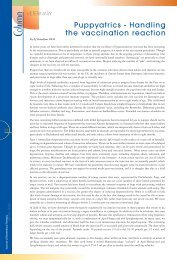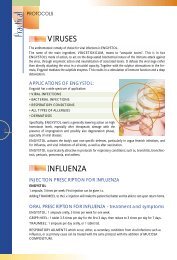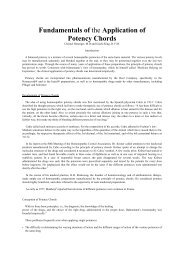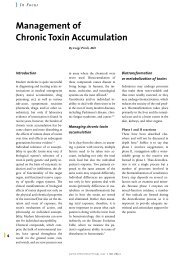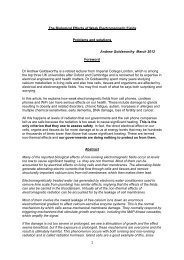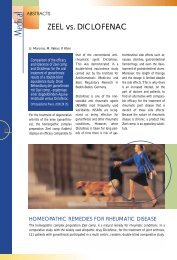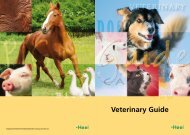Journal BT Fall 2003 - Bio Pathica Ltd
Journal BT Fall 2003 - Bio Pathica Ltd
Journal BT Fall 2003 - Bio Pathica Ltd
Create successful ePaper yourself
Turn your PDF publications into a flip-book with our unique Google optimized e-Paper software.
Pediatric issues and<br />
Homotoxicology<br />
PROTOCOLS<br />
Nocturnal enuresis (Bedwetting)<br />
Bedwetting is a common pediatric problem which poses a psychosocial problem for both children and parents. An estimated 5 to 7<br />
million children in the United States have enuresis. Nocturnal enuresis refers to involuntary passage of urine during sleep. Mostly the<br />
cause for enuresis is non-organic, and it is thought to be the result of delayed maturation of the nervous system with poor bladder control<br />
at night. Another theory postulates the insufficient production of antidiuretic hormone (ADH) at night. Psychological stressors<br />
play no role in the development of bedwetting, but the condition itself may be a psychological stressor for the child.<br />
Protocol<br />
Product Action Comment<br />
By the Medical Editor<br />
Plantago-Homaccord Functiotropic for the bladder Homaccords in general have supportive action on<br />
the organ function. They are almost always added in<br />
the treatment of diseases on the right of the<br />
inflammatory phase.<br />
Hormeel Stabilizing hormonal function Can also be used in boys, including for male acne.<br />
Ovarium compositum (in girls), Testis Experimentally to facilitate Composita and Injeels with glandular extracts<br />
compositum (in boys) or Hypothalamus brain maturation should not be used more than three times a week.<br />
suis-Injeel (for either sex)<br />
Nervoheel or Nereel Anxiolytic This is used in children where the anxiety<br />
around the condition makes it worse.<br />
Tonico-Heel Tonic to the brain Can be used as well to facilitate the inhibitory<br />
function of the brain.<br />
Attention Deficit Hyperactivity Disorder (ADHD)<br />
ADHD is often a very difficult diagnosis to make. It is widely believed to be overly diagnosed and medicated. Incidence is reported<br />
to be between 1-20% with 7.4% of children in the US being the more accurate definition. Some children only present attention deficit<br />
problems, others only hyperactivity, but often a mix of the two is present. The following can help differentiate either condition.<br />
Lack of Concentration<br />
At least six months with six of the following symptoms:<br />
• Often no attention to details – mistakes during activities<br />
• Cannot hold concentration during homework and play<br />
• Apparently doesn’t hear what is said to him/her<br />
• Cannot follow explanations<br />
• Cannot fulfil homework and tasks of daily living and at school<br />
• Cannot organize homework and tasks<br />
• Easily distracted<br />
• Forgetfulness during day to day living<br />
Protocol<br />
Product Comment<br />
Hyperactivity<br />
At least six months with six of the following symptoms:<br />
(Severity is not in keeping with the age of the child)<br />
• Frequent fidgeting with hands and feet, cannot sit still on a chair<br />
• Cannot stay in his or her seat (e.g. at school)<br />
• Excessive running around or climbing<br />
• Excessive noise during playing, cannot play quietly<br />
• Excessive movement which cannot be influenced by social contact<br />
or education<br />
• Excessive talking, often interrupts others<br />
• Cannot wait for his or her turn<br />
• Interrupts and often disturbs others during conversations and playing<br />
Selenium-Homaccord Homaccords support the function of the organ. For this reason Selenium-<br />
Homaccord can be used in both senile dementia and ADHD. It is used as a<br />
basic remedy in ADHD.<br />
Coenzyme compositum or Ubicoenzyme drops Cellular activation.<br />
Psorinoheel or Tuberculinum–Injeel forte Use in children who are daydreaming and who are restless.<br />
Spascupreel Often effective in children with concentration loss, also with aggression and<br />
hyperactivity. It contains Agaricus (which acts on involuntary movements and<br />
ticks as well as on being spaced out), Phosphor (indicated for hyperactive<br />
and flighty) as well as Belladonna and Veratrum (acts on anger).<br />
Cerebrum compositum Organ support for the brain.<br />
Neuro-Heel Add in children with severe disorders.<br />
Practical<br />
Winter 2006<br />
<strong>Journal</strong> of <strong>Bio</strong>medical Therapy<br />
5
6<br />
<strong>Journal</strong> of <strong>Bio</strong>medical Therapy<br />
Winter 2006<br />
Practical<br />
PROTOCOLS<br />
Vaccination<br />
Apart from the effects of the hygiene hypothesis mentioned in the editorial, vaccination poses other problems. It is postulated that attenuated<br />
virus particles can stay in the body for a long time, act as haptens and become incorporated into DNA, which theoretically can<br />
lead to cancer and auto-immunity. In terms of the theory of Homotoxicology, it will thus be a cause of progressive vicariation.<br />
Therefore, it is important to do deep cleansing after the event, and also to stimulate the Th1 arm of the immune system.<br />
Detoxification after vaccination<br />
Product Duration Comment<br />
Galium-Heel/Galium 3x/day for 5 days before and Deep detoxification.<br />
comp.-Heel after vaccination<br />
Schwef-Heel 3x/day for 5 days before and Cellular activation.<br />
after vaccination<br />
Psorinoheel/Sorinoheel 3x/day for 5 days before and Contains Thuja which is classically used<br />
after vaccination after inoculation.<br />
Engystol 3x/day from day 5 to 10 after In vitro evidence shows that it increases IL-1, 6-TNF<br />
vaccination alpha, thus the Th1 arm of the immune system.*<br />
* Glatthaar-Saalmüller: Personal communication, data not yet published.<br />
Depression<br />
Adolescence is a difficult transition time for most children. The demands the modern world puts on children contributes further<br />
to social isolation as well as problems with body image and acceptance.<br />
Studies indicate that one in five children has some sort of mental, behavioral or emotional problem, and that one in ten may have<br />
a serious emotional problem. Among adolescents, one in eight may suffer from depression. Among all these children and teens<br />
struggling with emotional and behavioral problems, a mere 30% receive any sort of intervention or treatment. The problem may<br />
be further perpetuated by the use of certain acne medications such as isotretoinin. Adolescent groups on these medications should<br />
be closely watched for symptoms of depression.<br />
Antihomotoxic medicine can offer a safe, gentle alternative in these cases, unless severe intractable disease is present. A recent<br />
article in the Lancet examines aberrations in the Hypothalamus-Pituitary-Adrenal (HPA) axis as a possible influence on suicidal<br />
behavior. It is thus wise to give some sort of support to this axis in these cases.<br />
Protocol<br />
Product Comment<br />
Neuro-Heel This product is good for patients with anxious depression and irrational<br />
fears. Can also be used in patients with eating disorders.<br />
Tonico-Heel This product works better in patients with exhaustion<br />
concomitant to the depression.<br />
Thalamus compositum or Hypothalamus For support of the HPA axis.<br />
suis-Injeel + Glandula suprarenalis suis-Injeel<br />
Cerebrum compositum Organ support for the brain.<br />
General dosage for children<br />
The following dosages may be used for all protocols discussed above.<br />
Age Normal dosage Acute dosage<br />
Infants under 12 months 1/3 of the adult dose 4x/day, 1/3 of the adult dose<br />
Small children up to 6 years 1/2 of the adult dose 6x/day, 1/2 of the adult dose<br />
6-12 years 2/3 of the adult dose 8x/day, 2/3 of the adult dose<br />
12 years and older Adult dose Adult dose



